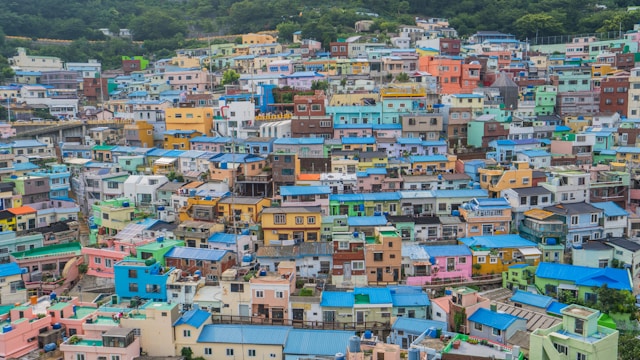
South Korea is a land of rich traditions, dynamic history, and cultural depth. Among its major cities, Busan and Daegustand out as two destinations that offer unique experiences, blending history, modernity, and tradition. While Busan is famed for its stunning coastal scenery and vibrant cultural scene, Daegu captivates visitors with its historical heritage and deep-rooted traditions. In this comprehensive exploration, we delve into the cultural and historical depths of Busan and Daegu, comparing their attractions, traditions, and significance in South Korea’s development.
Busan: South Korea’s Coastal Gem
1. Historical Significance of Busan
Busan, South Korea’s second-largest city, has played a pivotal role in the country’s history. As a strategic port city, it served as a gateway for trade, cultural exchange, and defense.
- During the Korean War (1950-1953), Busan became a refuge for those fleeing the North, leading to its rapid expansion and economic growth.
- Gamcheon Culture Village, once a settlement for war refugees, is now a vibrant artistic hub, showcasing murals and installations that tell the city’s history.
- The UN Memorial Cemetery pays tribute to fallen soldiers from various countries who fought during the Korean War.
2. Cultural Heritage and Landmarks in Busan
Busan is home to some of South Korea’s most cherished cultural and religious sites:
- Beomeosa Temple – A serene Buddhist temple nestled in the mountains, offering insight into Korea’s spiritual traditions.
- Haedong Yonggungsa Temple – A rare seaside temple, renowned for its breathtaking location and spiritual significance.
- Jagalchi Fish Market – A bustling marketplace reflecting Busan’s maritime heritage, where visitors can sample the freshest seafood.
3. Modern Attractions and Festivals in Busan
Busan seamlessly blends tradition with modernity, offering vibrant attractions:
- Haeundae Beach and Gwangalli Beach – Popular for their scenic beauty and nightlife.
- Busan International Film Festival (BIFF) – One of Asia’s most prestigious film festivals, drawing global filmmakers and cinephiles.
- Shinsegae Centum City – Recognized by the Guinness World Records as the world’s largest department store.
Daegu: The Heart of Korea’s Traditional Heritage
1. Daegu’s Historical and Cultural Roots
Unlike Busan’s coastal charm, Daegu is known for its deep historical and cultural legacy:
- Once the capital of Gyeongsang Province, Daegu played a vital role in Korea’s early trade and textile industries.
- Donghwasa Temple, dating back to the 9th century, stands as a testament to Korea’s Buddhist heritage.
- Daegu Yangnyeongsi Museum of Oriental Medicine highlights the city’s role as a center for traditional Korean medicine since the 1600s.
2. Architectural and Religious Landmarks in Daegu
- Gyesan Catholic Church – One of South Korea’s oldest Catholic churches, showcasing European-style architecture.
- Apsan Park and Observatory – A historic location offering panoramic views of Daegu and insight into its role during past wars.
- Seomun Market – Dating back to the Joseon Dynasty, this market is a haven for traditional Korean textiles and street food.
3. Festivals and Modern Attractions in Daegu
- Daegu Chimac Festival – Celebrating the city’s love for fried chicken and beer, a favorite Korean pairing.
- Daegu International Opera Festival – Showcasing world-class opera performances and reinforcing Daegu’s reputation as Korea’s classical music hub.
- E-World & 83 Tower – A modern amusement park with a landmark tower offering breathtaking city views.
Culinary Contrasts: Busan vs. Daegu
South Korea is a paradise for food lovers, and both cities offer distinct culinary delights:
Busan’s Iconic Dishes:

- Hoe (Sliced Raw Fish) – Freshly caught seafood served sashimi-style.
- Milmyeon (Wheat Noodles) – A unique take on cold noodles, developed during the Korean War.
- Dwaeji Gukbap (Pork Soup with Rice) – A hearty dish originating from Busan’s working-class history.
Daegu’s Famous Foods:
- Makchang (Grilled Pork Intestines) – A local delicacy popular in Daegu’s nightlife scene.
- Napjak Mandu (Flat Dumplings) – Thin dumplings with savory fillings, a must-try street food.
- Gopchang Jeongol (Beef Intestine Stew) – A rich, flavorful hotpot dish loved by locals.
Comparing the Lifestyles: Busan vs. Daegu
1. Climate and Geography
- Busan enjoys a milder, coastal climate with beautiful beaches and ocean breezes.
- Daegu, known as the “hottest city in Korea,” experiences extreme summer temperatures but offers stunning mountainous landscapes.
2. Economic and Industrial Contributions
- Busan’s economy is driven by its port industry, tourism, and international trade.
- Daegu is recognized as South Korea’s textile and fashion capital, playing a crucial role in the country’s industrial development.
3. Lifestyle and Urban Development
- Busan is a cosmopolitan city with a dynamic nightlife, modern infrastructure, and a strong international presence.
- Daegu maintains a balance between tradition and urbanization, offering a slower, more traditional lifestyle.
Conclusion: Two Unique Cities with Rich Legacies
Both Busan and Daegu offer a unique blend of history, culture, and modernity, making them essential destinationsfor those exploring South Korea. Whether one prefers Busan’s vibrant coastal charm and dynamic cultural scene or Daegu’s historical depth and traditional elegance, these cities collectively contribute to the rich tapestry of South Korea’s heritage.